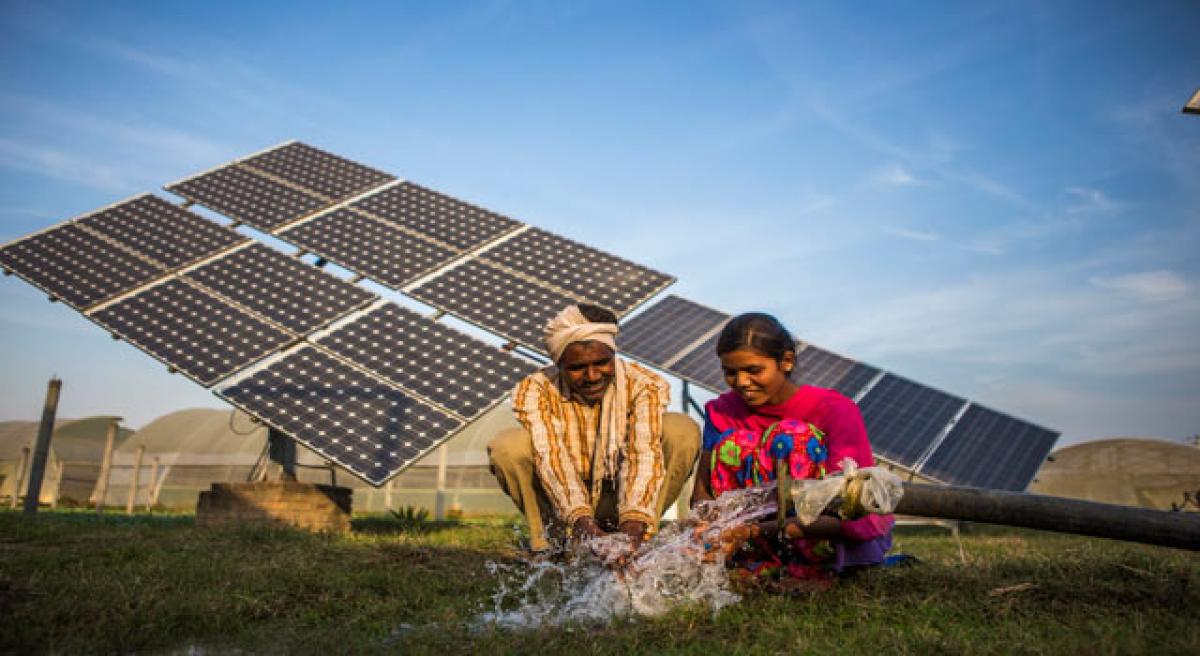Live
- ‘Get Set, Grow Summit 2024’ Focuses on Digital Detox for Families
- Stokes motivates his team to put in extra effort, says England pacer Potts
- From overcoming setbacks to leading India in U19 Women’s Asia Cup, Niki Prasad's amazing journey
- Driving Enterprise Security: Inside Venkata Reddy Thummala’s Leadership Journey
- Constitution debate: PM Modi hails 'Nari Shakti'; makes strong pitch for 'United Bharat’
- Abhijeet Bhardwaj: Revolutionizing Enterprise Analytics with Innovation and Expertise
- Bihar: Inquiry initiated against principal who went to buy veggies during school hours
- Press Sri Lankan Prez for release of Indian fishermen: TN Cong MP to EAM Jaishankar
- TN: DMK postpones executive meet due to heavy rains & Parliament session
- Porous silicon oxide electrodes can fix durability issues in batteries: Researchers
Just In

Phodabhai Parmar, a 72-year-old farmer, sits on a charpai sipping tea as solar panels gleam in the fields behind him. Parmar is one of six farmers who have formed the world’s first solar irrigation cooperative in Dhundi village in Gujarats Kheda district, about 90 km from Ahmedabad.
A SPICE Initiative
Phodabhai Parmar, a 72-year-old farmer, sits on a charpai sipping tea as solar panels gleam in the fields behind him. Parmar is one of six farmers who have formed the world’s first solar irrigation cooperative in Dhundi village in Gujarats Kheda district, about 90 km from Ahmedabad.
The Solar Pump Irrigators' Cooperative Enterprise (SPICE), which began operating in May 2016, not only made a switch from diesel to solar pumps but also adopted net metering selling excess power to the local electricity utility.
Members now have an incentive to save power and curtail their groundwater use, as any leftover power is sold to the Madhya Gujarat Vij Company Limited (MGVCL), the local power utility, thereby creating a parallel revenue stream. India is the largest user of groundwater in the world.
By 2012, it used an estimated 230 cubic kilometres of groundwater per year over a quarter of the global total. More than 60 per cent of irrigated agriculture is dependent on groundwater and if current trends continue, in 20 years about 60 per cent of all aquifers will be in a critical condition, the World Bank has said.
SPICE signed a 25-year power purchase agreement to sell power to MGVCL at the rate of Rs 4.63/kWh. With six solar pumps and a total capacity of 56.4 kWp (kilowatt peak, which stands for peak power and is the output achieved by a solar module under full solar radiation), the irrigation systems in Dhundi are expected to generate 85,000 kWh/year of solar energy, according to a paper published by IWMI-Tata Water Policy Programme, which initiated and partly funded SPICE.
The pump owners will use 40,000 kWh/year for irrigation, and sell the remaining 45,000 kWh/year to the grid, earning Rs 3 lakh a year. By December 2016, the six members had together earned more than Rs 1.6 lakh.
"The selling of power to the grid attaches an opportunity cost to the power that is being generated by the solar pumps, which otherwise would be free power," Neha Durga, a consultant with IWMI-Tata Water Policy Program, told IndiaSpend. "So even if farmers use the pumps for 100 days of the year for irrigation, for the other 200 days the grid is getting green power.
At the same time the farmers now have an incentive to economise on their energy as well as water use." In 2015, nine million diesel pumps -- expensive and big greenhouse gas emitters were being used for irrigation, largely due to lack of electricity connections or poor power supply.
Yet, the upfront cost of a solar pump, about 10 times that of a conventional pump, discourages buyers. Capital subsidy and financing support are a must to promote adoption of solar pumps, said a 2014 analysis by Shakti Sustainable Energy Foundation.
The SPICE experience is instructive. Farmers who joined initially contributed Rs 5,000/kWp towards the capital cost of solar pumps. The balance Rs 59,000/kWp was subsidised by a research grant from IWMI.
The total project, which consisted of six solar pumps and infrastructure-like grid lines and electricity poles, cost Rs 50 lakh for 56.4 kW capacity, Durga said. Rs 15 lakh was spent on constructing the grid and the rest was the cost of solar pumps.
"However, four new farmers who joined the collective later paid Rs 25,000/kWp, which is four times more than the initial participants, because they saw the benefits," Durga said.
By October 2016, 92,305 solar pumps had been installed throughout the country 31,472 during 2015-16 alone, more than the total installed during the past 25 years (since the beginning of the programme), according to the MNRE.
Based on the Dhundi solar experience, IWMI-TATA suggests that state governments scale down capital cost subsidy on solar pumps to around Rs 50,000/kWp from the average Rs 90,000 offered in 2016, and use the savings to offer farmers the opportunity to sell power to the grid at a feed-in tariff of Rs 7.0-7.5/kWh.
By Mukta Patil

© 2024 Hyderabad Media House Limited/The Hans India. All rights reserved. Powered by hocalwire.com







